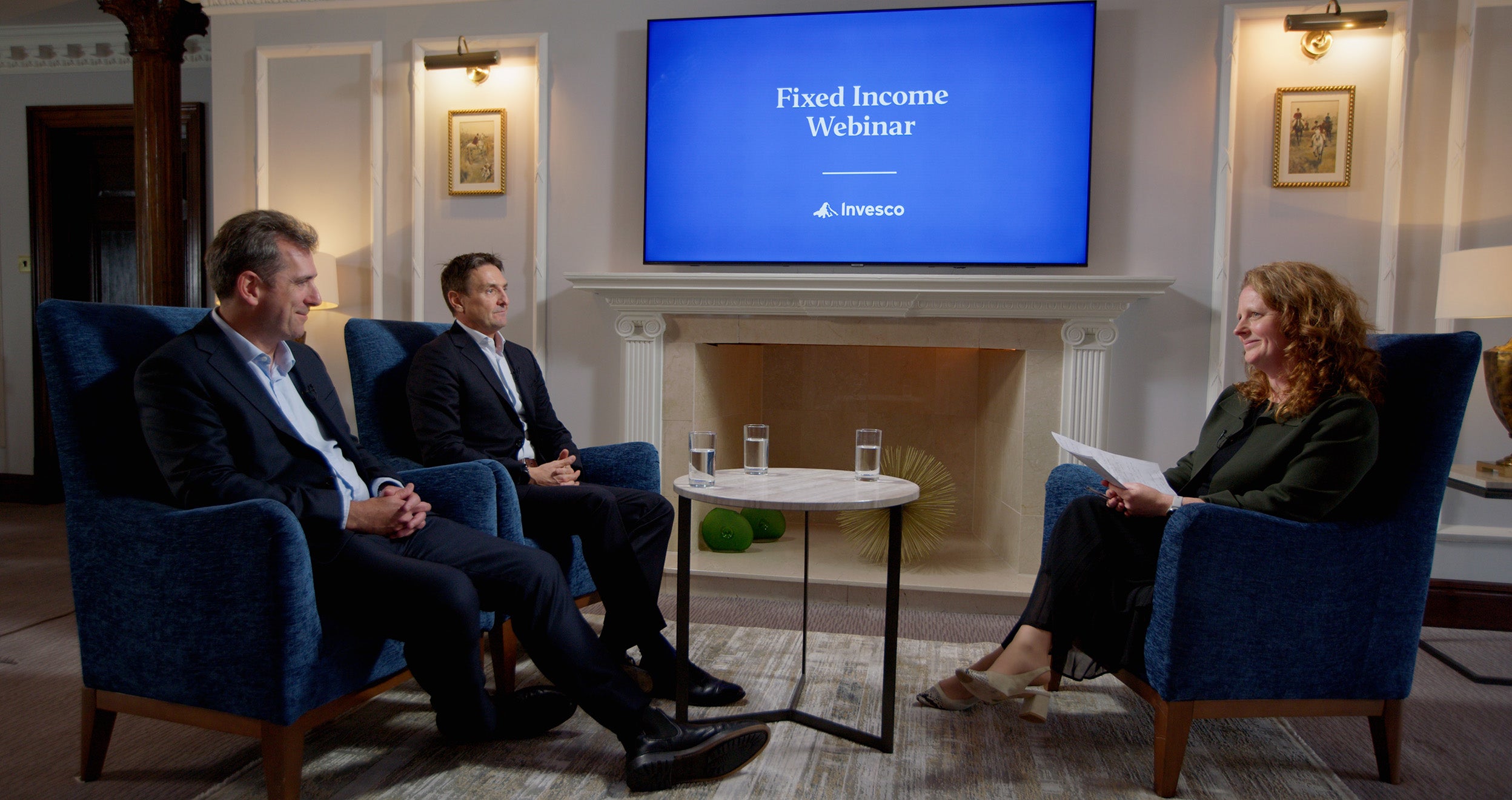
Paul Jackson
BSc in Economics from the London School of Economics and a Master of Philosophy in Economics from Oxford

On 9th October, Georgina Taylor, Head of Multi-Asset Strategies UK team and Fund Manager, hosted the webinar ‘New Horizons: Face the future of Fixed income investing’, featuring insights from experts across our Fixed Income, Asset Allocation Research and ETF teams. You can watch the replay on-demand here or read our summary below.
2024 started off with a strong case for the fixed income markets, following previous years of market volatility. As we enter the final quarter of the year, our experts look back at the ‘year of the bond market’ and share their thoughts on the outlook for Fixed Income assets going forward.
The stars are aligning for fixed income assets in a way that they have not done since before the global financial crisis (GFC). Central bank interest rates have been historically low, which has driven bond yields down to very low and unattractive levels. However, in 2022 and 2023 central banks began a tightening policy and since then bond yields have risen. The fixed income assets in the developed world have now started giving us yields that are closer to what we would have expected before the GFC. So, the market is no longer distorted.
During 2024, more than 40 central banks have cut interest rates. Importantly, the US Federal Reserve has now joined them, and its first-rate cut was a big 50 basis point reduction. So as central banks are bringing down their policy rates, that pulls down the short end of yield curves, which usually has a knock-on effect at the long end of the curve as well. Nonetheless, we're going to see a big steepening of yield curves, which in many countries had become inverted.
When you look back at the history of movements in yield curves, across the globe, when yield curves flatten, equities tend to outperform government bonds. The reverse is true when yield curves steepen. I think there is a chance now that government bonds will outperform equities.
This is why both strategically and cyclically, for the first time in quite some time I am now favouring fixed income assets, specifically government bonds and investment grade credit. I'm willing to say that bonds are back.

Paul Jackson
BSc in Economics from the London School of Economics and a Master of Philosophy in Economics from Oxford
Do you feel that this macro backdrop supports all the areas that you cover or do investors still need to be a little bit more selective, given how far fixed income has moved?
You always need to be selective when investing. Central banks are moving at different paces; most are cutting rates; some are more cautious. This creates a different landscape for investors. Historically, interest rates have been very low, and volatility has been very low. As Paul covered over the last few years, rates have come up, and volatility has increased, presenting more opportunities to generate returns from interest rate strategies or from currency strategies, or from curve strategies. That's where I think there is some value within these markets.
Where are you seeing the best opportunities?
The increase in volatility we have seen creates a large toolkit for macro investors to be able to generate returns. It's been a strong period for high yield and for investment grade credit. We favour government bonds within the US and in Europe, where we think the market has underestimated the level of interest rate cuts by those central banks, we like the UK as well.
How have Fixed Income ETFs performed this year, following the summer of volatility?
There has been an increase of flows into fixed income ETFs in recent years with investors using them for a variety of purposes including as an asset allocation tool to quickly manoeuvre their portfolios and to react to different environments.
European fixed income ETFs have seen net inflows of over $50bn so far this year. However, analysing the breakdown of those flows indicates some investor caution with cash management and very short duration government bond ETFs accounting for around 40% of net inflows in 2024.
So, have you seen a change in investor behaviour, how are investors responding to some of that macro volatility?
ETFs are increasingly being used for rapid asset allocation, investors are able to switch between one asset class and another quite easily. In August, we saw the unwind of the yen carry trade. It caused a bit of market volatility and spreads, which had been trading at the tightest levels for quite some time in credit markets widened as part of that volatility

Gareth Isaac

Paul Syms
Please share your high-level thoughts what the state of the markets means for EM and how you're thinking about investing, going forward?
Over the last year or so, a lot of Emerging Market (EM) central banks have been very orthodox in hiking rates early to combat inflation. Central banks in Latin America and Central and Eastern Europe have continued to ease policy rates and now that the Fed has begun its easing cycle, it opens the door for possible rate cuts across Asian central banks too. In our opinion, we believe EM duration interest rates are attractive as monetary policy normalisation should benefit fixed income risk assets in the region, both in local currency and hard currency. We prefer EM local currency from a valuations perspective, but believe hard currency EM credit spreads can still continue to perform in line with market beta.
What are the risks associated with investing in emerging market debt?
The risk return trade-off is balanced in the asset class. We have a preference for EM local currency because of its favourable risk reward profile over EM hard currency but believe both segments within EM should continue to perform. The strength of the US economy Fed policy stance and global capital flows this year have kept real yields in most EM’s at very high levels, which present a unique opportunity for investors relative to developed markets.
What are the real opportunities for investment grade credit?
Over the last year, we have seen a rally and a tightening of credit premiums. At the end of 2023, a lot of central banks, particularly the Fed, reached the peak of those policy rates and markets began to expect quick monetary easing and credit spreads tightened significantly.
A reason for this is in 2022 and 2023, a lot of investors expected negative growth, and demanded a higher premium to compensate for a potential recession, which in fact did not materialise. Currently the economic environment looks reasonably benign; for investment grade we only need reasonable growth, as most of these companies are blue chip corporates who have managed their debt effectively. The compression of this spread premium therefore reflects better corporate health and better prospects economically. There is still a case for investment grade as a core allocation. We don't see spreads tightening significantly further from here, but for the year ahead, we're looking to clip coupon payments and potentially generate some extra return from the government or risk-free side.
What have you been doing in your portfolios?
We have been looking to increase the quality of our portfolios over the last year. So, we've been leaning away from the riskier side of the market, which has significantly rallied year to date. We've also been allocating some selective portions of our portfolio into government related entities, which in certain cases offer you a decent spread given their high credit quality and government backing. We've also been holding a certain portion of our portfolios within Treasury bonds, which offer a decent yield and give us a bit of protection. So, we have been reclaiming risk budget.
The sectors that we like include banks and insurance companies, particularly European so-called national champion banks. There's an extra premium on offer for European credit since the end of 2022, which can compensate for the slightly higher downside risks for economic growth.
We've been less inclined for US industrials because US valuations have come into levels that are less attractive to us on a relative basis.

Gerald Evelyn
MBA, BA degree

Matthew Chaldecott
The value of investments and any income will fluctuate (this may partly be the result of exchange-rate fluctuations) and investors may not get back the full amount invested
All data is provided as at 15 August 2024, sourced from Invesco unless otherwise stated.
Views and opinions are based on current market conditions and are subject to change.
This is marketing material and not financial advice. It is not intended as a recommendation to buy or sell any particular asset class, security or strategy. Regulatory requirements that require impartiality of investment/investment strategy recommendations are therefore not applicable nor are any prohibitions to trade before publication.
Information for clients in Israel: This material may not be reproduced or used for any other purpose, nor be furnished to any other person other than those to whom copies have been sent. Nothing in this material should be considered investment advice or investment marketing as defined in the Regulation of Investment Advice, Investment Marketing and Portfolio Management Law, 1995 (“Investment Advice Law”). Neither Invesco Ltd. nor its subsidiaries are licensed under the Investment Advice Law, nor does it carry the insurance as required of a licensee thereunder.
EMEA 3933697 2024